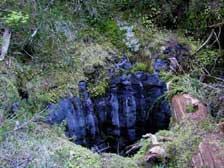Safety issues on karst terrain (lesson 10)
On this page
Learning objectives
This lesson discusses some of the safety issues associated with karst terrain. By working through this lesson you will be able to:
- Recognize some of the safety concerns for forest workers and members of the public
- Identify best management practices for forest worker and public safety
Introduction
As you work through this lesson, you will understand how forest workers and members of the public need to take more precautions when conducting activities on karst terrain.
Issues and challenges
What are some of the safety issues associated with karst terrain?
- Ground hazards, such as deep shafts, grikes, sinkholes, and thin ceiling caves
- Water hazards, such as swallets
- Blasting in limestone
- Road subsidence
- Managing public access to potentially hazardous surface karst features or caves
Recommended best management practices
The following section summarizes the recommended best management practices for safety issues on karst terrain. Be sure to check out more detailed information in the Karst Management Handbook for British Columbia.
Worker safety
The following best management practices are recommended:
- All potential safety hazards (for example, cave entrances, sinkholes, grikes, swallets) should be clearly identified on the ground with flagging or signs
- Forest workers should be informed of the hazards and safety concerns associated with karst prior to beginning operations (for example, tailgate sessions)
- Forest workers should avoid working alone, or carry radios and institute a worker-check system
- Discourage forest workers from entering caves or surface features on the work site
- Crews should receive extra training on specialized blasting techniques in limestone
- Forest workers should take extra precautions when blasting in limestone and avoid taking cover near surface features with connections to the subsurface
- Rubber mats should be used to contain flying rock
- Use caution when driving on roads through karst terrain, particularly in areas where roads are susceptible to subsidence or sudden collapse due to sinkhole formation
- Be aware of dangerous surface openings (for example, shafts, grikes) that may be hidden by forest litter or logging slash
- Maintain flags and other markers around surface karst features to identify potential hazards during post-harvest treatments, such as planting, spacing or pruning
Public safety
The following best management practices are recommended:
- Where public recreation sites and trails are maintained on karst landscapes, post warning signs at parking areas and hazardous sites where appropriate
- Where possible, restrict public access to maps indicating the locations of hazardous surface karst features or caves
- Consider removing access to extremely hazardous surface karst features or caves
Self check questions
Answer either True or False to check your understanding.
- Prior to beginning operations, forest workers should be informed of the hazards and safety concerns associated with working on karst
- Forest workers should be encouraged to explore caves on the work site
- Where appropriate, warning signs should be posted to inform the public of potentially hazardous karst sites
Self check answers
- True
- False
- True

